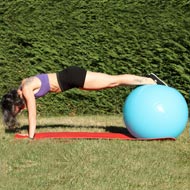Strengthen Your Ankles To Avoid Foot Drop
Foot drop (also known as drop foot) can be described as a medical problem, which makes it difficult for you to lift the front part of your foot. It is not a disease, but more like the symptom of a deeper underlying condition, which could be anatomical, neurological or muscular.
People suffering from this problem are often seen dragging the front of their feet when they walk. Foot drop can be permanent or temporary, depending upon its causes.
In case you are suffering from foot drop, your doctor may ask you to wear a brace on your foot and ankle, so that your foot is held in the normal position.
You may also be asked to practice a few exercises as a part of physical therapy to strengthen your ankle, improve your gait and reduce the symptoms of foot drop. There are many useful exercises for foot drop that you can practice each day.
Chair Exercises
Make sure that your exercise regime for foot drop includes the use of a chair, as it can provide support, stabilize the body and improve overall balance. Start with toe raises, in which you need to –
- Stand behind a firm chair and place both your feet shoulder-width apart
- Place both your hands on the top of the chair
- Inhale deeply and slowly lift your weight on your toes. Maintain this pose for a couple of seconds.
- Exhale slowly and gently lower your body to its original position.
Practice this exercise around 10 times, before pausing for a few seconds. Repeat a set of 10 toe raises after the brief pause.
Isometrics
These exercises can help strengthen the muscles in your ankle without you moving your ankle joint. To practice these exercises –
- Sit upright in a firm chair and extend your legs in front of you
- Place your right foot at the top of your left foot
- Push your left foot up against the right one gently
- Use your right foot to resist the movement of the left one
- Hold this tense position for at least 10 seconds
- Release the tension and allow yourself to relax for around 8 to 10 seconds
Repeat this exercise 10 times for each foot.
Table Exercises
You could enhance your ankle strengthening exercise routine for foot drop by using table legs as a prop.
- Sit or stand upright in front of a table
- Place the inner side of your right foot against the leg of the table and press the foot into the table leg
- Hold the position for at least 10 seconds
- Release the tension and allow yourself to relax for around 8 to 10 seconds.
Repeat this exercise 10 times for each foot.
Yoga
A certain pose in yoga, known as Vrikshasana or The Tree Pose is excellent for increasing the strength in the ankles, calves and thighs. For this pose, you need to –
- Stand straight and place your feet slightly apart
- Raise both your arms over your head and brings your palms together, touching each other
- Lift your right foot slowly and place it against the side of your left knee
- Breathe normally, while you stay in this position, for around 10 seconds
- Allow your body to return to the normal position gradually
- Relax for around 10 seconds or so
Repeat this exercise 5 times with each side.
While the ankle strengthening exercises for treating foot drop mentioned above are quite safe if practiced correctly, make sure that you check with your doctor before trying any of them.
Read more articles from the Yoga Exercises Category.

 Find Pose
Find Pose

